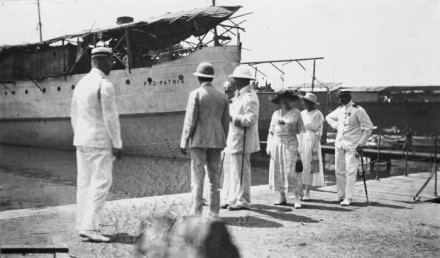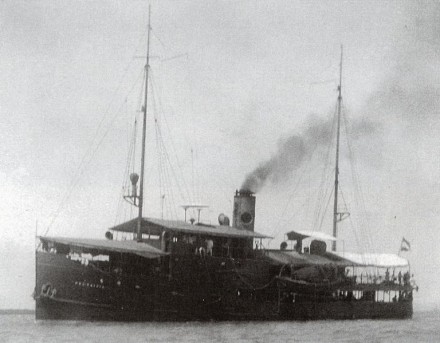History
Minelayer and work with torpedoes
The Hr. Ms. Pro Patria was built in the former Dutch East Indies. It was primarily intended as a minelayer but also used as a torpedo support vessel (a ship that does support work surrounding torpedoes such as repairs, deliveries, recovery, etc.)
During WWII the ship was put to work a lot. In December 1940 the Pro Patria laid mines in the eastern fairway near Surabaya under the island of Madura. Late in 1941 the ship operated from Palembang, Sumatra and laid blockades in the Musi river.

Attacked
On February 15th, 1942, a blockade of 40 mines was being laid in the mouth of the river. On the same day, the Pro Patria was attacked by Japanese airplanes.
Commander Guiot was informed via radio that a Japanese invasion fleet lay in front of the entrance of the Musi river. Upon hearing this, the commander decided to scuttle the minelayer in the river, due to the low speed and bad maneuverability of the Pro Patria. After the ship had sunk, a large part of the crew managed to escape to Java.
Victims
The episode caused the death of two crewmen. An Indonesian boy named Samar died on February 15th on board of the ship and Military Sailor Johan Frederik Jaap Willemsen died later, aged 30, in Jakarta (then Batavia).
Description
Yard: Navy Establishment in Surabaya, Java
Armament:
1 x 7,5 cm cannon
2 x 12,7 mm machine gun
60 mines

| Master | L.F. Guiot |
|---|---|
| People on board | 62 |
| Length | 154 ¼ feet (47 m) |
| Width | 28 ¼ feet (8.6 m) |
| Draft | 9 ¼ feet (2.8 m) |
| Tonnage | 537 ton |
References
- L.L. von Münching (1978).
Schepen van de koninklijke marine in de 2e wereldoorlog. p. 67. - Oorlogsgraven stichting.
Oorlogsgraven stichting.